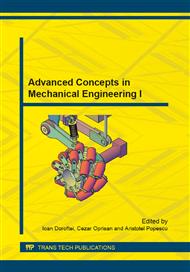[1]
F. Alwahdi, F.J. Franklin, A. Kapoor, The effect of partial slip on the wear rate of rails, Wear, 258, 2005, pp.1031-1037.
DOI: 10.1016/j.wear.2004.03.052
Google Scholar
[2]
K. L. Johnson, Contact Mechanics, Cambridge: Cambridge University Press, (1985).
Google Scholar
[3]
U. Olofsson and R. Levis, Wheel-rail interface handbook, Woodhead Publishing, (2009).
Google Scholar
[4]
G. Xie, S. D. Iwnicki, Calculation of wear on a corrugated rail using a three-dimensional contact model, Wear, 265, 2008, pp.1238-1248.
DOI: 10.1016/j.wear.2008.01.026
Google Scholar
[5]
T.X. Wu and D.J. Thomson, An investigation into rail corrugation due to micro-slip under multiple wheel/rail interactions, Wear, 258, 2005, pp.1115-1125.
DOI: 10.1016/j.wear.2004.03.060
Google Scholar
[6]
S. Cretu, Contactul concentrat elastic-plastic, Politehnium, Iași, (2009).
Google Scholar
[7]
F.W. Carter, On the action of a locomotive driving wheel, Proc. R. Soc. Ser. A 112, 1926, p.151–157.
Google Scholar
[8]
S. L. Grassie and K. L. Johnson, Periodic microslip between a rolling wheel and a corrugated rail, Wear, 101, 1985, pp.291-309.
DOI: 10.1016/0043-1648(85)90134-6
Google Scholar
[9]
J. Dahlberg and B. Alfredsson, Transient rolling of cylindrical contacts with constant and linearly increasing applied slip, Wear, 266, 2009, pp.316-326.
DOI: 10.1016/j.wear.2008.07.008
Google Scholar
[10]
Standard VDA 230-206 (part 1).
Google Scholar
[11]
F. Chen and M. Trapp, Automotive Buzz, Squeak and Rattle, Mechanisms, Analysis, Evaluation and Prevention, Butterworth-Heinemann, Oxford, (2012).
DOI: 10.1016/b978-0-7506-8496-5.00001-4
Google Scholar


